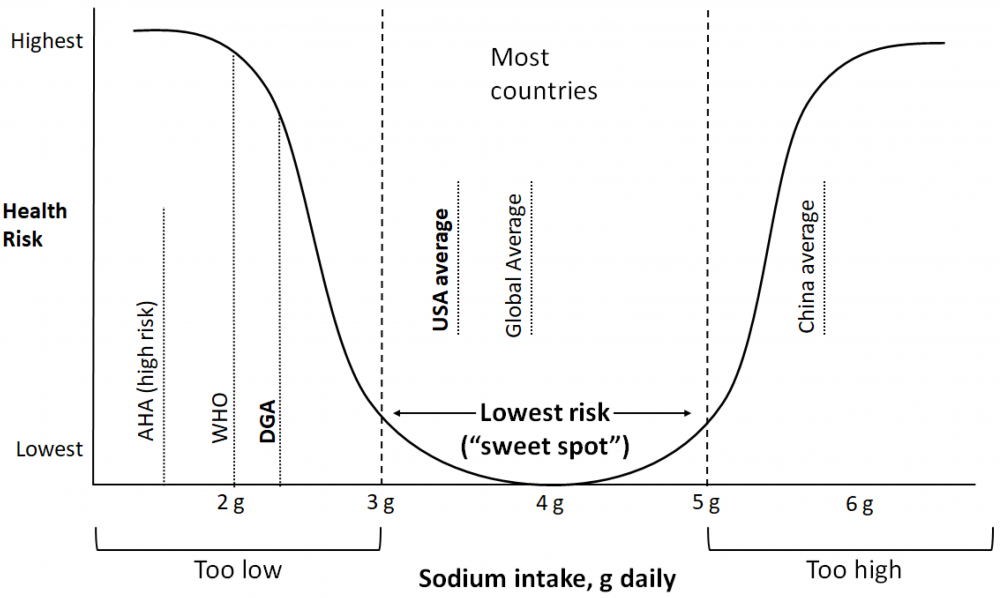对盐的看法 吃与活2022-09-26 20:44:55
我在实践周福满的时候,盐吃得很少。后来由于新的观点和研究结果的出现,我对限盐改变了看法。下面是我目前的观点:
1. 日常盐的量用在我味觉感到合适的下限。就是说,感到味道够了,就不要再加盐了。
2. 高盐显然不好。盐吃得多,你的体液就多,血液体积就大。如果你调节血压的机制有些问题,就可能造成高血压。
3. 过低的盐也不好。主要原因有二:A, 盐吃得太少,血液体积就降低。你的身体对低于正常的体液的一个反应是激活肾素,血管紧张素和醛固酮系统。长期激活这些激素对身体是有害的。B,较新的研究认为盐不仅在体液中,也存在于皮肤中,参与对抗微生物入侵的免疫反应。如果身体含盐太少,人的抗病能力会下降。另外,有研究表明低盐可能是骨质疏松的危险因素,有网友怀疑低盐头发白得快。虽我没有看到有关文献,但不排除这种可能。
4. 对于采用生酮饮食的人来说,要适当补充盐分,也就是食物不能太淡。因为生酮饮食导致胰岛素降低,这使肾脏排钠增加。如果不从饮食中获得足够的钠,身体就不能维持正常的血液容量,导致血压过低。
对高血压而言,限盐也是治标的一种,其实与吃药没有太大区别。最后要提的一点是:一种营养成分的合适的量一般是呈U字形的,有一个理想的范围,太多或太少往往都不好。盐的事情还有很多可说,我知识有限,所见不多,就聊这么多吧。推荐下面一篇文章, 其观点我基本赞同。各位根据下面的摘要文字和文章最重要的图来决定是否看正文。我翻译水平有限,采取谷歌翻译,谬误难免,敬请注意,不清楚之处请参考原文。
Sodium Intake and Health: What Should We Recommend Based on the Current Evidence?(谷歌翻译:钠摄入量与健康:根据目前的证据,我们应该推荐什么?)
https://www.mdpi.com/2072-6643/13/9/3232/htm#B24-nutrients-13-03232
Several health organizations recommend low sodium intake (below 2.3 g/day, 5.8 g/day of salt) for entire populations, on the premise that lowering of sodium intake, irrespective of its level of intake, will lower blood pressure and, in turn, will result in a lower incidence of cardiovascular disease. These guidelines were developed without effective interventions to achieve long term sodium intakes at low levels in free-living individuals and without high-quality evidence that low sodium intake reduces cardiovascular events (compared with average levels of intake). In this review, we examine whether advice to consume low amounts of sodium is supported by robust evidence. We contend that current evidence indicates that most people around the world consume a moderate range of dietary sodium (3 to 5 g/day), that this level of intake is associated with the lowest risk of cardiovascular disease and mortality, and that the risk of adverse health outcomes increases when sodium intakes exceeds 5 g/day or is below 3 g/day. While the current evidence has limitations, it is reasonable, based upon prospective cohort studies, to suggest a mean target of below 5 g/day in populations, while awaiting the results of large randomized controlled trials of sodium reduction on cardiovascular disease and death.
谷歌翻译摘要:
一些健康组织建议整个人群的钠摄入量较低(低于 2.3 克/天,5.8 克/天的盐),前提是降低钠摄入量,无论摄入量如何,都会降低血压,进而,会降低心血管疾病的发病率。这些指南的制定没有有效的干预措施来实现自由生活个体的长期低钠摄入量,也没有高质量的证据表明低钠摄入量可以减少心血管事件(与平均摄入量相比)。在这篇综述中,我们检查了是否有强有力的证据支持摄入少量钠的建议。我们认为,目前的证据表明,世界上大多数人的膳食钠摄入量范围适中(3 至 5 克/天),这一摄入量与心血管疾病和死亡率的最低风险相关,并且当钠摄入量超过 5 克/天或低于 3 克/天时,不良健康后果会增加。虽然目前的证据有局限性,但基于前瞻性队列研究,建议人群中的平均目标低于 5 g/天,同时等待关于减少钠盐对心血管疾病和死亡的大型随机对照试验的结果是合理的。

Figure 1. Conceptual diagram of health risk by sodium intake levels based on the current evidence. The lowest risk range (i.e., “sweet spot”) for sodium intake is at ~3 to 5 g/day, with both lower and higher levels of intake associated with higher risk of cardiovascular disease or death. The Dietary Guidelines for Americans (DGA) recommendation for sodium corresponds with a higher risk of adverse health outcomes.
谷歌翻译:图 1. 基于当前证据的钠摄入量健康风险概念图。 钠摄入量的最低风险范围(即“最佳点”)约为 3 至 5 克/天,摄入量越低或越高,心血管疾病或死亡的风险越高。 美国人膳食指南 (DGA) 对钠的建议与不良健康后果的风险较高相对应。我的注释:3到5克钠大体对应于8到12克盐。